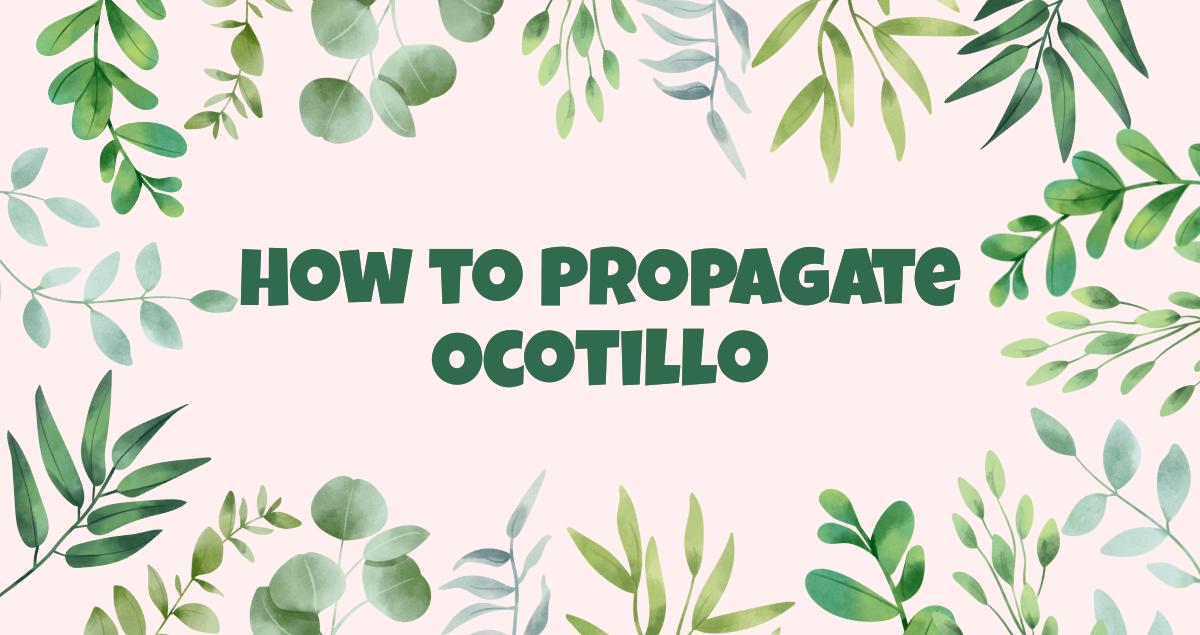Propagation is the process of reproducing plants from their existing parts, such as seeds, stems, or roots. Ocotillo, also known as Fouquieria splendens, is a unique desert plant native to the southwestern United States and northern Mexico. It is characterized by long, spiny stems and vibrant red flowers that bloom after rainfall. Understanding how to propagate ocotillo can be a rewarding and fulfilling experience for plant enthusiasts.
Table of Content
How to Propagate Ocotillo
To propagate ocotillo, gather cuttings from healthy plants in spring or fall. Allow the cuttings to dry for several weeks before planting them in well-draining soil. Water sparingly and provide partial shade until roots develop. Ocotillo cuttings can take several months to root, but with proper care, they will grow into new plants.
What is Ocotillo?
Ocotillo is a distinctive plant that belongs to the Fouquieriaceae family. It is commonly found in arid desert regions and can grow up to 20 feet tall. The plant features multiple spiny stems that emerge from a central base, resembling a cluster of tall, slender branches. During the spring and summer months, ocotillo produces bright red tubular flowers that attract hummingbirds and other pollinators. Its unique appearance and ability to thrive in harsh desert conditions make it a popular choice for landscaping and gardening.
Why Propagate Ocotillo?
There are several reasons why one might choose to propagate ocotillo. Firstly, propagating ocotillo allows you to expand your collection of these unique plants without having to purchase new ones. It can also be a cost-effective way to create a visually appealing desert landscape in your garden. Additionally, propagating ocotillo can help preserve the species and ensure its survival, as some populations are threatened in their natural habitats. By propagating ocotillo, you can contribute to the conservation efforts of this remarkable desert plant.
Methods of Propagating Ocotillo
There are several methods you can use to propagate ocotillo, each with its own advantages and challenges. Here are four common methods:
1. Seed Propagation
Seed propagation is one of the most natural ways to propagate ocotillo. To collect seeds, wait until the plant has finished flowering and the seed pods have dried out. Gently remove the seeds from the pods and prepare them for planting. Sow the seeds in well-draining soil and keep them moist until germination occurs. It's important to note that seed propagation can be a slow process, as ocotillo seeds can take several weeks or even months to germinate.
2. Stem Cutting Propagation
Stem cutting propagation is a more expedient method of propagating ocotillo. Start by selecting a healthy stem and cutting it into sections, each around 6 to 8 inches long. Remove the leaves from the bottom half of the stem and allow the cut end to dry and callus for a few days. Once calloused, plant the cuttings in a well-draining soil mix and keep them lightly moist. With proper care and favorable conditions, the cuttings should develop roots within a few weeks.
3. Division Propagation
Division propagation involves separating an existing ocotillo plant into multiple sections to create new plants. This method is best done during the dormant season when the plant is not actively growing. Carefully dig up the ocotillo plant and divide it into sections, ensuring that each section has enough roots to sustain growth. Replant the divided sections in well-draining soil and provide regular watering until they establish themselves.
4. Grafting Propagation
Grafting is a more advanced method of ocotillo propagation and is typically done by experienced gardeners or horticulturists. It involves joining a piece of ocotillo stem, known as the scion, onto the rootstock of a different plant. Grafting allows for the combination of desirable traits from both plants, such as increased vigor or disease resistance. However, it requires precise techniques and careful monitoring to ensure successful union between the scion and rootstock.
Factors Affecting Ocotillo Propagation Success
1. Environmental Conditions
Creating the right environmental conditions is crucial for successful ocotillo propagation. Ocotillo thrives in full sun and well-draining soil. It is important to provide adequate sunlight and ensure the soil is not overly compacted or waterlogged. Ocotillo also prefers warm temperatures, so it is best to propagate during the spring or early summer when the weather is favorable.
2. Timing
The timing of ocotillo propagation can greatly impact its success. It is best to propagate ocotillo during the plant's active growing season, which is typically from spring to early summer. During this time, the plant is more likely to produce new roots and establish itself in its new environment. Avoid propagating during the dormant season, as the plant may be less responsive to propagation efforts.
3. Care and Maintenance
Proper care and maintenance are essential for the success of propagated ocotillo plants. Water the newly propagated plants regularly but avoid overwatering, as ocotillo is adapted to arid conditions. Provide occasional deep watering to encourage root development. Additionally, protect the young plants from extreme temperatures or frost by providing temporary shade or covering them during cold spells.
Common Challenges and Troubleshooting
1. Rooting Failure
Rooting failure can occur for various reasons when propagating ocotillo. One common cause is overwatering, which can lead to root rot. Ensure that the soil is well-draining and only water when the top inch of soil feels dry. Another possible reason for rooting failure is using unhealthy or diseased plant material. Always select healthy stems or seeds for propagation to increase the chances of success.
2. Disease and Pest Control
While ocotillo is generally resistant to pests and diseases, it can still be susceptible to certain issues. Common pests that may affect ocotillo include aphids and spider mites. Regularly inspect the plants for any signs of infestation and treat them accordingly. Additionally, ocotillo can be prone to fungal diseases, especially if the soil is consistently damp. To prevent fungal issues, ensure proper drainage and avoid overwatering.
Conclusion
Propagation of ocotillo can be a rewarding and enjoyable process, allowing you to expand your collection of these unique desert plants. Whether you choose to propagate through seeds, stem cuttings, division, or grafting, each method has its own benefits and challenges. By understanding the factors that affect ocotillo propagation success and providing proper care, you can increase your chances of successfully propagating this remarkable desert plant. So why not give ocotillo propagation a try and add a touch of desert beauty to your garden?
Frequently Asked Questions
How long does it take for ocotillo to root?
Ocotillo cuttings typically take around 2-3 weeks to root. It is important to provide them with well-draining soil and keep them in a warm and sunny location during this time.
Can a fallen ocotillo be replanted?
Yes, a fallen ocotillo can be replanted. However, it is crucial to wait until the plant has developed calluses on the cut ends before attempting to replant it. This usually takes about 2-3 weeks. Once calluses have formed, the ocotillo can be placed in well-draining soil and watered sparingly until it establishes new roots.
How long does it take for an ocotillo to grow?
Ocotillo plants can take several years to reach their full height, which can range from 10 to 20 feet. The growth rate of ocotillos largely depends on factors such as soil conditions, climate, and available sunlight. With proper care and favorable conditions, ocotillos can grow approximately 1-2 feet per year.
When should I prune my ocotillo?
The best time to prune ocotillo is during the dormant season, which is typically in late winter or early spring. Pruning during this time allows the plant to recover and regrow before the active growing season begins. It is important to use sharp and clean pruning tools to avoid damaging the plant, and to remove any dead or damaged branches to promote healthy growth.
What is the best soil mix for propagating ocotillo?
When propagating ocotillo, it is recommended to use a well-draining soil mix. A suitable mix can be created by combining equal parts of sandy soil, perlite, and organic compost. This mixture provides the necessary drainage while also retaining some moisture for the developing roots.
Can ocotillo cuttings be rooted in water?
While it is possible to root ocotillo cuttings in water, it is not the most effective method. Ocotillos prefer well-draining soil, so rooting them in water can lead to rotting of the cuttings. It is generally recommended to use a well-draining soil mix for better success in propagating ocotillo cuttings.
How often should I water newly propagated ocotillo cuttings?
Newly propagated ocotillo cuttings should be watered sparingly. It is important to allow the soil to dry out between waterings to prevent root rot. Watering once every 2-3 weeks or when the soil feels dry to the touch is typically sufficient. As the cuttings establish roots and show signs of new growth, the watering frequency can be gradually increased.

